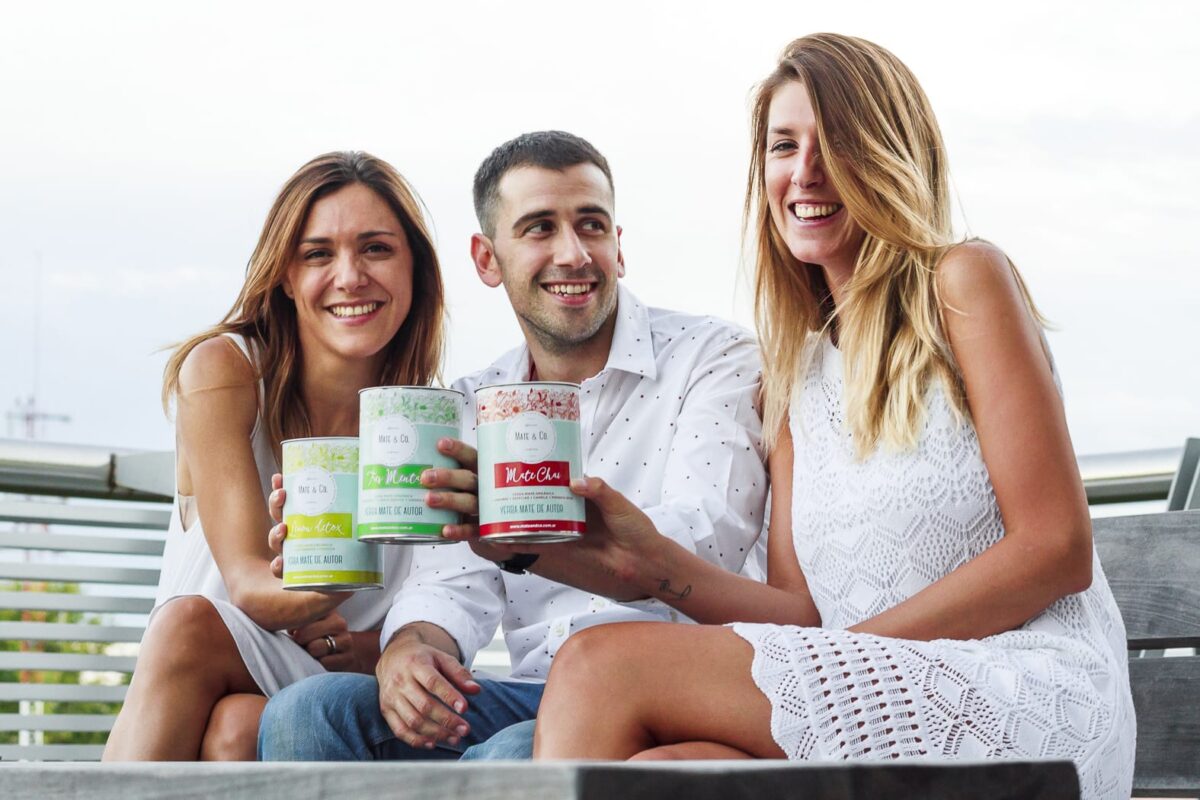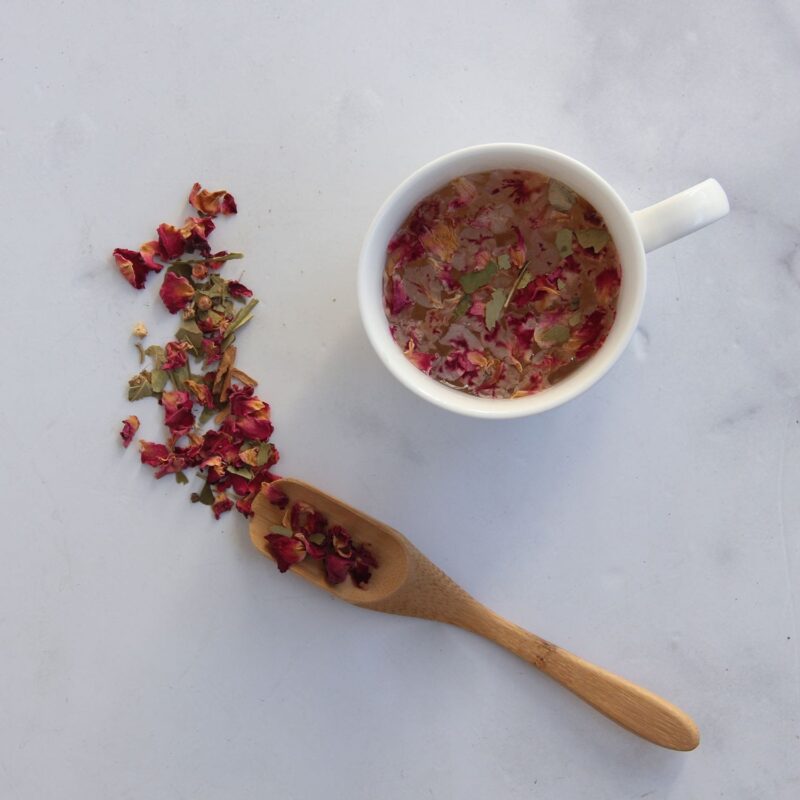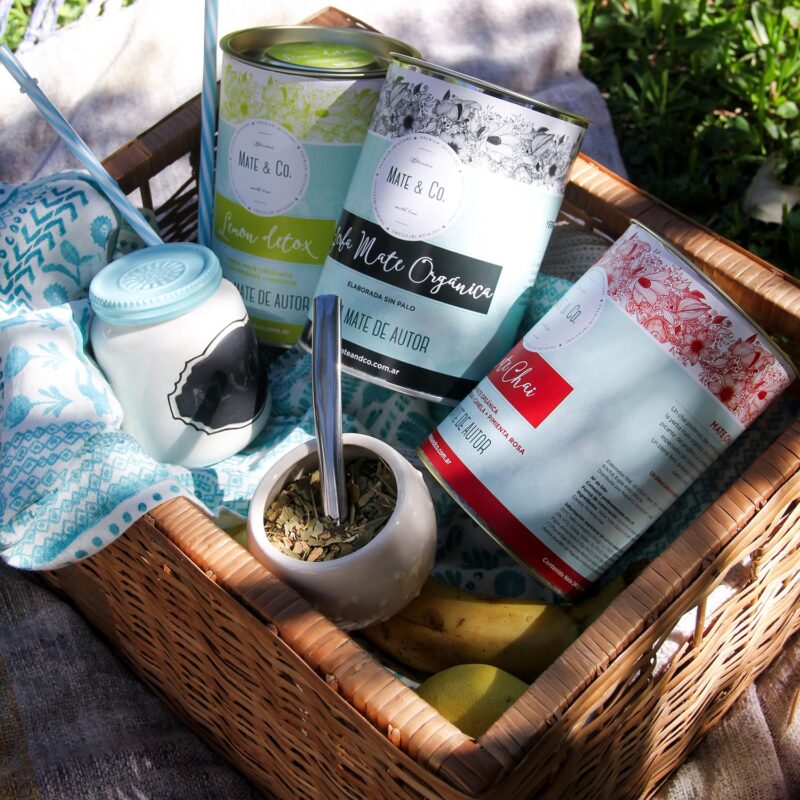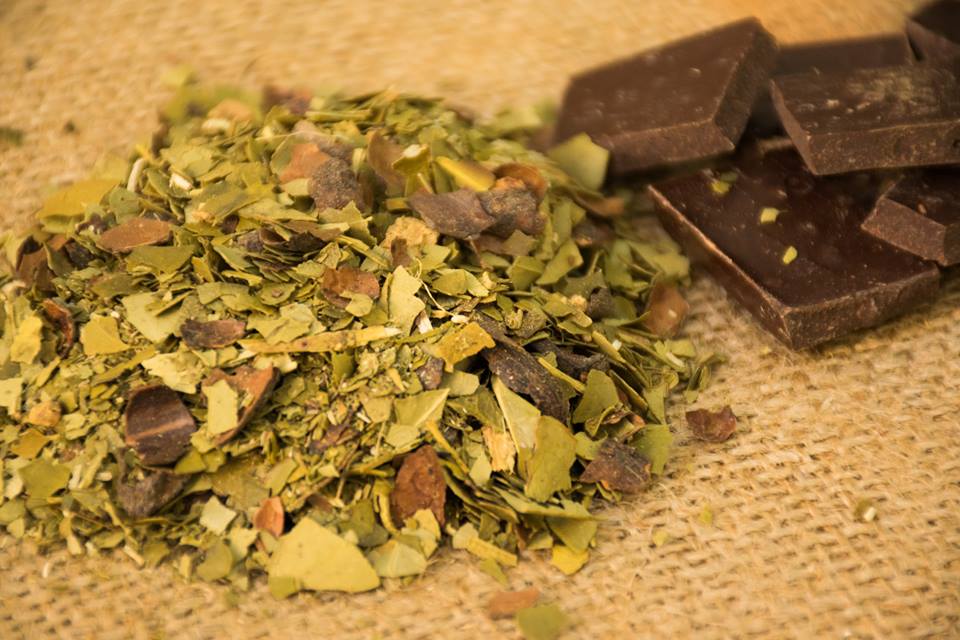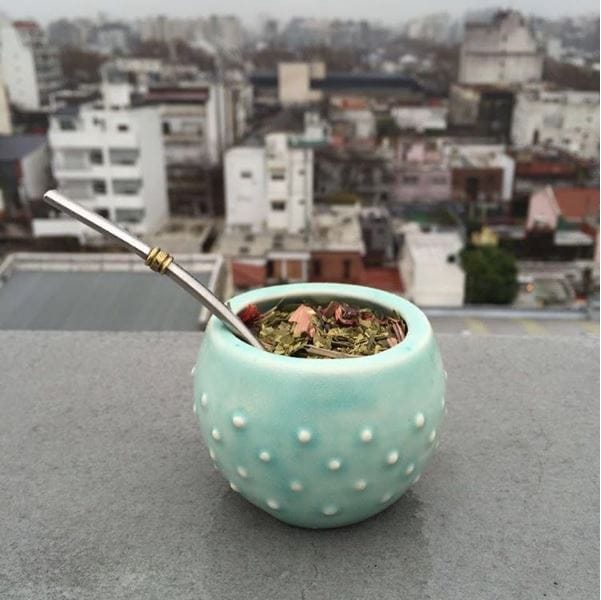Argentineans love Mate. It is a traditional South American infused drink that is prepared with yerba mate and hot water (but there’s also a cold version, called Tereré) on a hollow recipient and you sip it using a metal straw called bombilla. For those who don’t know, mate is rich in caffeine, B and C vitamins, as well as antioxidants. However, it transcends the beverage and it is also seen as a cultural custom. You share a mate with acquaintances and loved ones while working, studying or just hanging out.
Those with an adventurous side like to add some herbs to the yerba. But most people take it plainly, simply as you buy it. But no more… just a couple of years ago, Jimena Blasco, Marcela de Loredo and Martín Vijnovsky founded Mate & co. They have designed natural blends of yerba mate, giving it an innovative twist. Each combination contains organic yerba, herbs, spices and flowers; plus, it comes in lovely packaging.
Moreover, Mate & co. offers a great variety of products. Each tin contains a high quality blend: organic yerba; Flower Power (yerba, verbena, lavender and flowers); Chai (yerba, ginger, spices, cinnamon and pink pepper); Three Mints (yerba, peppermint, Egyptian mint and mint); Spicy Choco (yerba, cocoa husk and ginger); and Lemon Detox (yerba, lemongrass and hibiscus). Each combination not only has a unique flavour, but also different properties due to the ingredients. In addition to the yerba, they also developed mate’s kits which contain a ceramic recipient and a drinking straw.
De Loredo studied communication, so she works on that area as well as marketing. “Luckily, I have nothing to do with numbers because I have no idea about them,” she jokes.
Blasco is an economist, and as she explains, “We share an administrative and delivery role with Martín. Everything that has nothing to do with communication, which is Marcela’s field. So, the administrative and financial part is ours. We share the tasks, they are not assigned.”
Vijnovsky graduated from administration and described his career at several companies, related to software and communication: “I had a bunch of boring jobs.” Anyway, the friendly trio of entrepreneurs received us and we had a most pleasant conversation.
What is your working dynamic?
Jimena: We all work together when we’re launching a new product or when we’re dealing with a new idea. During everyday life, Marcela does the communication and Martin and I, the management part.
Martin: I could be not much original and say that we all do a bit of everything, as any entrepreneur does. Really, you do anything: from preparing orders to logistics.
Marcela: Literally, assembling the boxes for customers’ orders, sealing bags…
Martín: She could go on and on forever; what time do you leave? (laughs). Now, due to our growth as a company, we are about to start a period when you have to wear the long pair of trousers (a Latin-American expression related to coming of age) and start with the hard work. It’s difficult because you have a great deal of love invested in it.
What is Mate & co.’s history?
Martín: Before Mate & co. came out on the market we spent about two or three years just talking about the project. In fact, it was great because we contacted many friends who are entrepreneurs themselves and they gave us a hand. We were trying to be perfectionists with our undertaking and they were encouraging us to go on the market. Even though you have an idea on your mind, you have to make it compatible with the market’s requirements.
Marcela: We were really afraid of coming out on the market, because we had a product that hadn’t exist until then and we had a certain concept of the typical and traditional mate drinker. We believed that they wouldn’t like it. Since we thought that ours was a spectacular and delicious product, we hesitated: “What happens if people see it as a bit different, not so traditional but a bit daring and don’t like it?”
At a moment we thought of coming out with teabags because we wouldn’t dare to present it as mate. Actually, as Martín said, we connected with a beautiful circle of people that were in the same situation as entrepreneurs and everyone tried to help and told us to go on the market.You can make a mistake, change your product or undertaking, but you have to already be out in the market. It was just before Christmas; we had our product and said “Ready!”
What was it like, launching the brand, Mate & co.?
Jimena: We came out on the market almost unintentionally.
Marcela: I had the Facebook page set up for ages but didn’t release it publicly until then.
Martín: Yes, making our Facebook page public was like an initial shout to the world!
Jimena: Then, the orders started to be placed.
Marcela: We had a lot of orders because many people drink mate and the packaging is so lovely that you would want to give it away as a present. And it was awkward because we had a homemade undertaking so we weren’t able to keep up with them!
The three of you come from different fields. How did you prepare for the undertaking?
Jimena: During those initial years we had to study a lot because Mate & co wasn’t something that we were keen on. We were doing completely different things separately back then.
Martin: Yerba mate was a rubric that none of us were involved in before.
Jimena: Especially when you consider the complexity of manipulating a product and breaking with something that was so established.
Martín: We took a course on yerba mate at the Argentinean School of Sommeliers.
Jimena: And contacted many benchmarks of the area, such as Valeria Trapaga.
Marcela: We also took a course on tea, to learn how to create blends.
Jimena: We tried whatever there was on your mind regarding mixing herbs.
Martín: It’s a wonderful path because you end up learning a lot of things, from silly things such as knowing that there’s a Yerba mate flower (which is generally unknown to the consumer). And, as Marcela said, it’s such a traditional product that you use every day, but only then you discover who are the producers, how it is processed, how it changed through time, and it was marvellous.
So, how did Mate & co. come together?
Jimena: We were searching for suppliers to find the most wonderful organic yerba available in the market. It had to respond to our needs: to be nice to look at and smell, have great colour and quality, and to locate it and bring it here. There were a lot of premises that we wanted to respect.
Marcela: Besides, you became an expert on ridiculous themes such as flowers! Now, we can say things such as: “Oh no, this marigold is dreadful!” People stare at you thinking you’re messing with them but no, you spent every second of the day looking at marigolds, picking the most beautiful, with lots of colours, etc.
Martín: Yes, it’s a world apart, but we came here to have a clean break with tradition. We needed to meet high standards. Ours is a product that, compared to the rest of the market, it is not the less expensive. So, we have to make it worth to the consumer. As Jimena said, we had a producer to make the yerba’s thickness and process as we want them to be; the settling of the herb is natural made and takes fourteen months, which means having capital stopped for that period, so it is replicated to be able to compete in the market. In the end, there are many features that make the product better and are not negotiable. We are exquisite on some things, such as the visual image. We decided to create a product with a certain level of quality.
It’s a wonderful path because you end up learning a lot of things, from silly things such as knowing that there’s a Yerba mate flower (which is generally unknown to the consumer). And, as Marcela said, it’s such a traditional product that you use every day, but only then you discover who are the producers, how it is processed, how it changed through time, and it was marvellous. Martín Vijnovsky
From where did you get inspiration?
Marcela: The idea was to follow what had happened to the tea market. That is what really motivated us to do it. Yerba Mate has a lot of spectacular properties and those are highly valued abroad but this doesn’t happen in Argentina. We drink mate just because it is a tradition: you have done it since you were little and it’s delicious. And that’s it. You don’t choose it because it has antioxidants, vitamins and others.
There are millions of varieties of tea, but here you had only one of Yerba Mate. And if you added some sugar to it, people would have said it’s a horror. So, the idea was to stop and think for a moment about something that is taken for granted. We thought, Why can’t we do the same thing with Yerba? It was crazy that there wasn’t anything like that here. So, we started a train of thought: what do we add to it, why and how do you add value to it?
In addition to this, we take a stand on this natural and organic movement: to make something that is good for the body and to think how to complement it. So, each blend has something unique. For instance, Chai is energetic because it has ginger. It must add up to everything. And it must be pretty because it’s like an indulgence. You see the tin, you open it, you smell and feel it.
What were the consumers’ responses to the product?
Jimena: We had a good reception.
Martín: We realised that there was an unjustified fear from our side.
Marcela: It was spectacular but we have always had some cases of detractors and I cried on the inside thinking that they didn’t understand us. Nevertheless, when you are breaking structures you expect prejudices from people.
Martín: She is upset about it but, to be honest, I feel happy. In the end, it is about having the courage to be different. People are always going to criticise you.
Jimena: Maybe it was because our project was brand new and there was some aggressive comments, opposed to a great number of beautiful ones, but that one negative was always there.
Marcela: Truly, I thought we were going to need a kind of “education” stage for the consumers, to go out and do a show and tell about our products. However, we didn’t need it at all. People drank it, liked it and kept asking for it.
Martín: I was telling them about a client that wrote to us: “I got it and it was really better than what I thought.” It’s a silly thing, but we’re overwhelmed by this kind of comments because of all the effort behind the product.
Jimena: We also have recalcitrant fans.
Marcela: Yes! Obviously, we read all their comments and we’re over the moon.
Why do you think there wasn’t a lot of innovation regarding yerba mate?
Martín: In my view, it was the fear of a traditional product.
Marcela: For Argentineans, you don’t mess around with mate.
Jimena: But it is the beginning of a phase. As well as we developed our undertaking, nowadays there are a lot of things going on with yerba mate. There are people creating alcoholic beverages, and other innovative products. We wanted to introduce something beyond the tradition, and while we carried out our search we found other entrepreneurs that were on the same path.
Marcela: There are many chefs trying to incorporate yerba into their recipes. Truthfully, it is a spectacular product, but no one had done something with it apart from filling the mate recipient and drinking it.
Martín: I don’t know why, really.
Marcela: It was a real waste. Now, with this new “wave”, people will make the most of it and use it for several things.
Jimena: This has happened with Argentinean tea or wine. Local wine is not the same as it was ten years ago. And everything has to do with this. The raw material is the same: soil, air and work. But the added value you can offer and the perspective changes.
What makes Mate & co. a unique undertaking in Yerba mate’s market?
Jimena: In fact, the added value of this yerba is enormous: its quality, how we treat it as a raw material, how we create the blends. We’re all over it. Both the product and its packaging have a lot of thought put on them.
Martín: We manage a lot of natural products to make our yerba and it has nothing to do with some flavoured yerbas that you can find in the market. We went through a lot of hard work with an expert blender and we were pretty demanding. We were kind of skeptical and thought that everyone can make blends but, honestly, it wasn’t like that. We made tiny changes or had the product cut differently and it altered the flavour when hydrated. What fills the tin has a long process of setting up and nowadays you can’t find anyone who puts it in a similar packaging, and offers a completely natural product with such quality.
Marcela: There are brands that offer yerba with a lot of sticks that are superfluous to the flavour, but it translates into a heavier product. Others spray the products with artificial flavourings. Ours is a completely natural and pure product.
Why work with an organic yerba as a base?
Marcela: When we were learning about the yerba, we heard scary stories regarding pesticides and other stuff. Obviously, not everything is the same, but we decided to go for a natural approach, to offer something healthy to the organism. We tried to go back to the origins and find the best quality in each aspect. Bottom line, organic yerba had the best quality.
Martín: There are people who claim that mate gives them heartburn, so they cut out it from their diet. We tell them to try out our yerba and they respond that they didn’t have heartburn after drinking it. This happens due to a number of things. For starters, being organic means that it is less invasive to the body and it has less dust, which has an adverse effect. It is another added value. There’s an idea of having a 100% organic product but it requires a development of other local products that aren’t available in the local market yet or are extremely expensive.
Mate is closely related to a tradition and to sharing, something that foreign people may have trouble understanding. It’s a horror for them to share a drinking straw at first. Then, they come here, get inside the “ritual” and are fascinated by it. Marcela de Loredo
How do you work before launching a new blend?
Marcela: There are a few things that we take into consideration. For instance, the seasonality.
Martín: Spicy Choco came up for winter.
Jimena: And Flower Power for spring.
Marcela: The idea is to keep launching new blends. After so many courses and having worked with blenders, we already know a few combinations we would like to try.
Jimena: And we have been working with this type of product for almost four years now. I can’t say we’re blenders, but we have a certain amount of knowledge and we dare to create ourselves. We were much more afraid at first and after a few days we would realise what a disaster we had made. Nowadays, we have another mindset.
Also, we read the market, our sales and know what clients would value more. And obviously, we research and find out what’s available as a stable material. Furthermore, we talk to blenders about the specific features of each mix. So, in the end, it comes down to this kind of complete research that appears with the daily dynamic.
Marcela: But we also ponder about what we like. When there’s something we like, we push for it and make every one of our acquaintances taste it until it is approved.
Martín: This happens more to them than to me: “I want a blend with lavender”, and they keep repeating that as a bird continuously pecking on your head. They keep insisting until a new blend comes out of that idea. To put it briefly, there’s something magical in the creation process.
Marcela: We still come across of that sort of person that tells you, “I definitely won’t drink that,” because of prejudice to a certain ingredient or mix, and then they empty the tin.
Martín: I was with a friend on a five-hour travel by car. “No, I don’t drink mate. It gives me the creeps,” he said. He tasted one of our mates and emptied the thermos bottle by himself.
Marcela: And it has this thing: we drink many mates during the workday at the office and we used to drink the same. But now, we ask, “What should we drink now?” Now we have options and it is great! It also saves the time of mixing things by your own and maybe making some mistakes down the road.
Jimena: We have a few things in store that didn’t work out. Some blends that were just wrong.
Marcela: We make our family and friends try everything during some funny rituals of the creating process.
What about mate’s accessories?
Jimena: We have the mate recipient and the drinking straw that were extremely planned. For example, the latter is made of stainless steel because if you go for the organic path, then you must take care of this detail and not let so many germs on a rusty straw. It’s something serious but common people just don’t realise it.
Martín: Actually, people don’t think about it and then say ours is a great drinking straw.
Marcela: We discovered that the traditional mate recipient made of gourd or wood absorbs fungus. You use it forever but maybe if it’s under a microscope it doesn’t pass the test! Besides, if you want to really appreciate our several flavours, it is better to do so with a ceramic or glass recipient that won’t affect it and you can wash it and reuse it with another blend.
Can the Yerba mate blend be served also as a tea?
Jimena: We offer small tins of blends especially made for making tea, which were the first product to come out on the market. However, you can also make an infusion with our yerba mate blends.
Marcela: Yes, we tried it and it’s simply delicious. It’s just like a tea.
Jimena: But not similar to a mate cocido. (Another traditional beverage made with yerba)
When drinking mate for a long time lapse, flavour tends to fade. Why do you affirm that this doesn’t happen with your blends?
Marcela: Its taste is richer because it doesn’t have sticks, which are tasteless and occupy space in the package. It also has spices that are strong and fade more slowly. As a result, a mate that perhaps lasted half a thermos, now lasts two of them.
Martín: Actually, our chai blend may react contrary to what you said. Ginger usually reveals its flavour after a while. I mean, the first mate is soft, and then the ginger comes along. It’s great because you taste different things.
How would you introduce Mate & co. blends to someone who lives abroad and hasn’t got a clue about mate?
Martín: Good question. First, I would tell them: “Argentineans do this ridiculous thing: they grab a mate recipient, put yerba and water in it and pass it along, drinking and sharing the same drinking straw.” (He laughs.)
Marcela: Mate is closely related to a tradition and to sharing, something that foreign people may have trouble understanding. It’s a horror for them to share a drinking straw at first. Then, they come here, get inside the “ritual” and are fascinated by it.
Apart from that, I’ve seen several beverages elaborated with yerba mate abroad and it caught my attention. I mean, yerba is produced only in Argentina, Paraguay and Brazil but now is reaching the world. It is amazing because the planet is discovering this excellent product with a lot of properties: it has antioxidants and caffeine (it’s energetic, but it is not as damaging as coffee), amongst other things. So, it has both natural and cultural aspects.
Jimena: And let’s take into account that, as a blend of many ingredients, it doesn’t have a bitter or strong flavour, which foreign people used to reject. And to be honest, Yerba alone is less bitter than black tea. Anyway, the blend is better for a beginner’s experience. And we have a great reception amongst foreigners. Lately, a chef took some blends back to New York and has incorporated them in his restaurant’s menu.
Martín: There are various experiences. When we started investigating to set up the project, we realised that the world have started appreciating mate. We get a lot of stories such as “I was told that yerba mate was sold in a tea house in France.” I checked it and found that it was being sold as “the South American herb”. So, it has something really local because it’s produced only in three countries, which makes it kind of unique, but they are discovering it. There’s still a long way to go, because it is not something established as tea, for example, but there’s an easy way to introduce it to the world.
The core of our future as brand is to develop more varieties and products in several formats. Jimena Blasco
What are your plans for the future of Mate & co.?
Jimena: Basically, to keep launching blends. And we have a few ideas in store regarding mate’s complements. The core of our future as brand is to develop more varieties and products in several formats.
Martín: I believe we still have plenty of scope to grow here in Argentina.
Jimena: But we also are planning to come out to the world. One of our next steps is to offer our products abroad. We’re still on the research stage when it comes to it, but it will happen sometime in the future.
Marcela: The idea is to become a benchmark in the yerba mate sector. And even though our main line is yerba, we’re always thinking about the complements that are part of the mate’s ritual. In the beginning, the traditional line was present in each of them. So, we wanted to bring design and innovation to all of them. We started with the recipient, thinking about the model, the colours, and that it all should come close to a visual concept. We see it as an indulgence, a lovely present to buy and enjoy it with all senses. So, we want to change all the objects.
Jimena: Just like what happened to tea, wine and other products that broke the mould over the past years.
Martín: In fact, we usually say that we can dream as big as tea. We cannot think that we can’t get to that point. Obviously, we need to take it step by step and there are a lot of things to do. But we always have to maintain the quality promised to consumers and surprise them with new blends. At the same time, we need to see which is the best way to take our product to other markets. We’re kind of proud of our project and the idea of selling our product abroad.
Tags
blends / Buenos Aires / Innovation / Jimena Blasco / Marcela de Loredo / Martín Vijnovsky / mate / Mate & co. / yerba mate
blends / Buenos Aires / Innovation / Jimena Blasco / Marcela de Loredo / Martín Vijnovsky / mate / Mate & co. / yerba mate

